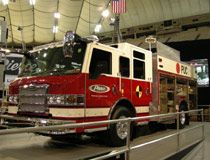 PHOTO BOB VACARRO The PUC’s design eliminates the bulk pumphouse. |
Fire apparatus service and maintenance is becoming easier as manufacturers unveil new designs, according to a leading industry figure.
Mike Moore, director of new product development for Pierce, told a special session on apparatus at FRI in Atlanta on Thursday that more and more manufacturers are keeping maintenance in mind when creating new products.
Pierce itself has concentrated on improved service access, diagnostics, prognostics – such as predictive failure software systems – and service and support on its latest designs, Moore said.
“There are trends that I think are happening,” he added. “A lot of other manufacturers out there are doing the same kind of stuff.”
Latest products
Moore cited the Velocity chassis and the PUC, both launched in the past 12 months by his company, as examples of designers paying more heed to maintenance needs once apparatus arrives at departments.
He said that manufacturers’ efforts are being helped by an apparent trend of more and more department technicians being involved in the apparatus purchasing process.
“I’ve seen over the past 10 years an increase in the amount of technicians involved with and that are on apparatus committees,” Moore said.
“Consequently we are starting to hear as manufacturers that voice coming through louder as to what things we can do in the design and building of trucks, which makes the manufacturing side of it that much easier.”
Many fire service leaders have long called for better communication between apparatus manufacturers and the departments themselves.
Moore said that maintenance and service of products are now the main things that Pierce looks at when designing new products.
“It’s important as manufacturers to start addressing those areas and make them easier to work on,” he said.
The easier it is to perform regular safety checks on vehicles in the firehouse, the more likely it is they are actually carried out, he added.
Interior components
One of the most significant yet seemingly small changes among manufacturers is the make up of interior components, according to Moore.
Pierce increasingly favors the use of rotationally molded consoles, dashboards and and trays rather than vacuum-formed plastics.
Moore compared the traditional methods to sticking your thumb firmly into a plastic bag, which thins out the area, similar to an interior component when a screw is put through it.
“That’s where cracking starts to occur,” Moore said, “and once that starts, there’s really nothing you can do to prevent it.”
The newer rotomolding method sees plastic put into a mold, which is then heated in an oven, allowing the plastic to fill all areas of the mold evenly.
New purchases
When it comes to actually purchasing new fire trucks, Moore said apparatus committees need to consider several things.
“What is important when you’re part of an apparatus committee is to look at a manufacturer’s parts and services support.
“Make sure you check the local dealerships, their service facilities – what are they able to provide for you?”
He added while virtually all manufacturers offer warranties, it is vital to check the small print and the financial stability of the company offering it.
Moore closed the session by noting the rapid advances in fire truck safety, which is beginning to take its lead from improvements in automobile design and testing.
But he said it was still the firefighters’ responsibility to take the ultimate safety measure – using seat belts.
“The industry is moving to make things easier and simpler,” Moore said. “But at the end of the day, you have still got to sit in that seat and click that belt to be safe.”

